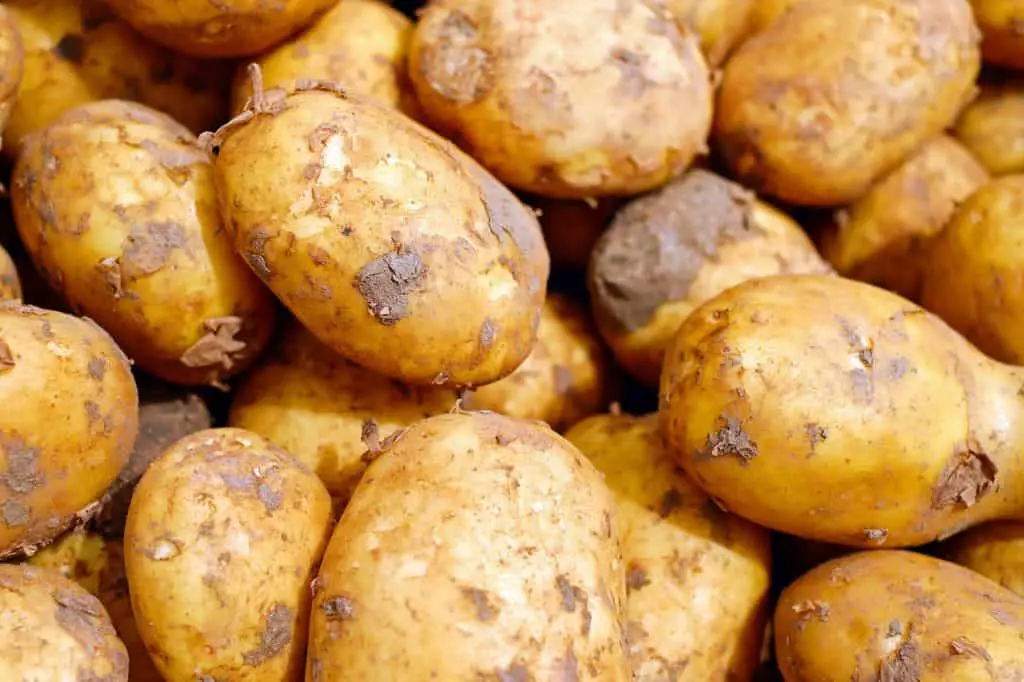
Potatoes are one of the greatest crops you can possibly have. They are a staple crop that is rich in calories and incredibly easy to grow! This has led many a novice gardener to ask, “can I grow potatoes with sprouted spuds?”
You can grow new potatoes from sprouted potatoes easily, regardless of if they came from a previous organic crop at home or from the supermarket. The process is the same for both. Form the soil into mounds, cut the sprouting eyes from the potato, burry the sprouts, water, and wait.
Naturally, there are a few more details to be aware of in this process, not to mention the harvesting and shelf-life of new potatoes, so keep reading to learn each step in better detail and to learn if it’s a good idea to use store-bought potatoes.
Can You Use Store-bought Sprouting Spuds?
Before we get into the “How-to” part of this article, many of you might be wondering if you can use the older spuds in your everyday grocery store. With that, there is good news and bad news.
The good news is yes, you can certainly achieve a new harvest of potatoes using the old potatoes you find at the store. The bad news is they are sprayed with growth inhibitors, such as Bud Nip, to prevent eyes from popping out for as long as possible. It’s one of the means grocery chains use to keep their potato produce as fresh as possible for as long as possible, in order to keep them appealing to the public.
If you intend to grow your own potatoes, using spuds with growth inhibitors won’t be an advantage for you if you intend to have crops growing on time. They also have a chance of harboring pathogens, but it’s a small chance and depends on how they were treated by the grocery chain.
Nevertheless, you can still use store-bought potatoes, especially when it’s too late to grow potatoes from seed.
What You Should Consider Before Growing Sprouted Potatoes
Before you get too excited and rush to plant your sprouted potatoes, there are two things to be aware of.
Make sure the temperature of the soil is between 45-50 degrees Fahrenheit so that any late frost you had doesn’t end up killing the plants. This is especially true with planting potatoes from seed.
Make sure the soil you intend to use drains well, is nutrient-rich, and has a pH rating between 4.8 and 5.5. Potatoes like acidic soil, but if it ends up too acidic, you can counteract the acid with sulfur. If there’s a lack of nutrients, you can supplement the soil with a 10-10-10 mix of nitrogen, phosphorus, and potassium (NPK).
How to Grow Sprouted Potatoes
There are a number of ways to grow your sprouted spuds, such as in,
- 5-gallon buckets
- Grow bags
- Raised beds with and without hilling
- The ground with and without hilling
The setting potatoes seem to prefer is being buried in the ground, so that is the growing condition we will focus on today.
Prepare Your Garden Bed
The key to any good crop production is proper soil preparation, and it’s no different with the hearty potato. The soil needs to be mounded into rows so that the potato spud and roots have as much room as possible to grow and develop.
You can create rows of mounds between 8” and 12” tall and 1’ apart with just your bare hands, but if you have larger potato plots, you might want to use a garden hoe or shovel. You want to prepare your soil first because once you prepare your potatoes, they need to be in the ground within 3 days.
Prepare your Potatoes
The first thing you need to do with the potatoes you plan to plant is storing them in a cool, dry location so that they don’t dry out or grow mold. Then, about 3-4 weeks before planting time, lay your “seed” potatoes on a tarp or cloth in a warm, sunny area with a moist burlap sack or paper towels laid over them. This promotes the growth of potato eyes.
When you are ready to prepare your potatoes, it’s time to count the “eyes,” sprouting from each spud.
Cut out each eye of your potato plant, and if an eye has multiple sprouts, keep them together. Each eye will become a new potato plant that you plant separately. You do NOT plant the entire potato all at once. As you cut, be sure to leave a small amount of potato attached to the new sprouts so that the skin of the potato will keep out diseases as a natural seal.
Finally, you want to plant them in the ground within 3 days before the sprouts dry up, which brings us to our next step.
Plant Your Potato Sprouts
Finally, you’ve come to the moment of truth! The moment you’ve wanted to get to. So here’s what you need to know to plant successfully.
Potato sprouts should be planted 12” apart from one another to give each sprout, or group of sprouts from the same eye, plenty of room to grow. You don’t need to plant your potato sprouts too deep, just 3-4” will do the trick. Too deep and you won’t have very large potatoes because there was too little room for them to grow.
When you plant your sprouts, make sure the cut side faces downward and sprout or sprouts face upward
Maintain Your Potatoes
Now that you’ve planted your new potatoes, you need to maintain the best growing conditions for them by making sure they get plenty of sunlight and that you water them frequently. If everything goes well, you should start seeing potato leaves shoot from the ground in a week’s time.
After you see your new potatoes, keep watering them the same and perform basic maintenance such as removing the weeds. If you live in a place with soil that isn’t especially nutrient-rich, go ahead and mound some fertilized soil at the base of the potatoes.
Harvest Your Potatoes
At last, after about 3-6 months, your potatoes are ready for harvesting! You can tell when your potatoes are ready to be harvested when the leaves above ground die off. This usually happens after your first frost, or in fall for those of you in warmer climates that don’t get a frost.
If your spuds grow too early, you can transplant them in new soil in a bucket and place them on a window sill or under a grow light to encourage more growth.
When you dig up the potatoes, all you really need is your bare hands, or maybe a trowel. Shake off the excess dirt from your spuds and then brush the remaining dirt off with some kind of soft vegetable brush. You don’t want to wash off the dirt because when you store your potatoes you risk mold growth.
As the proud grower of a new batch of potatoes, your potatoes should be shelf-stable for about 6-weeks without any preservation method, such as growth inhibitors.
Conclusion
Now you know precisely how you can grow a fresh new crop of potatoes from old, sprouted potatoes. Using the old store-bought spuds might not be the most ideal, but you will certainly succeed nonetheless and they work just fine if you can’t find potato seeds or it’s too late to grow by seed in your area.
